Four Seasons in Japan
Autumn 秋
Chapters 15 〜 20
Day 15 - Kyōto
Itinerary of the day
Photo gallery
Typical products and souvenirs
Yudōfu 湯豆腐
The tōfu is one of the most traditional foods in Japan, whose complex processing makes it difficult to make at home. As a result of curdling soy milk with nigari, the tōfu varies in softness and texture according to the pressing inside special hinoki wood molds. It has a delicate flavor, so it can be used in savory and sweet dishes.
Yudōfu is a simple Japanese dish consisting of soft tōfu, called soft, simmered in warm water and konbu seaweed, until it becomes warm and nutritious. This traditional autumn and winter dish is usually served in a Japanese earthenware pot called donabe.
In restaurants it is usually served at the center of the table where the stove is present, so that diners can serve themselves. Tsuyu sauce served with boiled tōfu is similar to soba soak sauce, mentsuyu. However, you can also enjoy yudōfu with other sauces such as ponzu or goma-dare.
It is usually served with many other side dishes such as pickles, rice and miso soup, to have a full and varied meal. In the Kiyomizu-dera temple area, where traditions are kept as much as possible, several restaurants offer their own tōfu in hot water. Restaurants like Okutan Kyomizu offer the chance to sample the excellent artisanal tōfu prepared in several variations, including yudōfu.
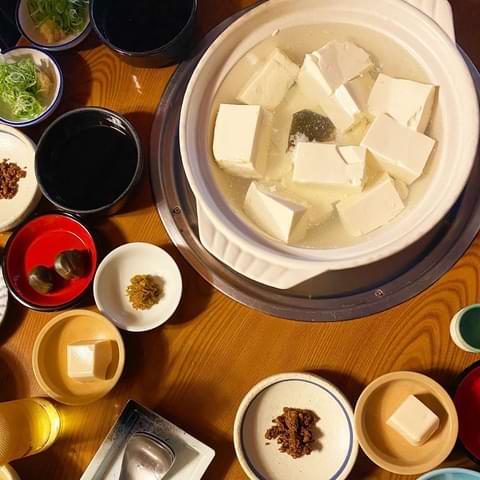
Yukata 浴衣 e Obi 帯
Thanks to its long tradition of processing and selling colorful fabrics, as well as the use of traditional clothing by geisha and maiko, Kyōto is undoubtedly one of the best places to choose your yukata or kimono.
The yukata is a casual spring-summer version of the kimono, worn mainly during the summer matsuri. Many hotels provide simple yukata similar to dressing gowns as chamber garments, while in ryokan and spa towns are garments used by guests in facilities or to move between the various onsen during sotoyu-meguri.
Yukata, being predominantly made of cotton, are more affordable than silk kimonos, and are highly regarded as souvenirs for foreigners. Near the Kiyomizu-dera Temple there are many shops that sell or rent these items at prices that also vary greatly depending on the manufacture and the press. Renting the yukata for a day costs between 20 and 30 euros.
To accompany the yukata there are obi, belts embroidered with different patterns and geometric designs usually made of silk, which give a magical touch to the garment itself. The beauty of these belts lies in their ability to match yukata of totally different colors, in addition to the fact that simply combining different obi to the same yukata, the look varies enormously.
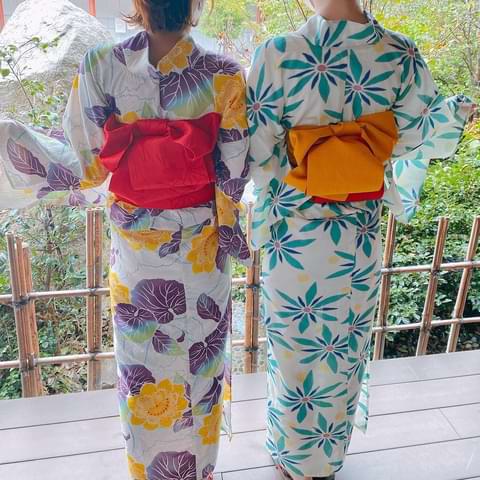
Kyō-sensu 京扇子 and Kyō-uchiwa 京団扇
Kyōto’s artisanal fans are divided into two categories: the sensu, or the classic folding models also used by geisha during their performances of dances and shows, and the uchiwa, round shape and straight handle.
The sensu are originally from Japan and have roots that refer to the city of Kyōto, hence the name Kyō-sensu. The oldest sensu fan in Japan dates back to 887 A.D. and appears to have been found inside a Buddhist statue of Tō-ji Temple. The sensu are divided into two categories depending on the processing: the first is the hari-ogi and consists of gluing a bamboo structure to paper panels (kamisen) or silk (kinusen); the second is the ita-it consists of thin lamellae of an aromatic tree such as the white sandal tucked inside special grooves of the frame.
The cheapest Kyō-sensu are used to find relief from the summer heat, while those with bamboo frame and painted silk frame can have considerable costs and are used as accessories in the Nō theater or as furnishing elements.
The uchiwa, of Korean origin, are built by joining fine bamboo strips to form a flat surface on which you will then glue the decorated paper or cloth. The number of bamboo strips varies from 50 to 100 defining the degree of quality of the accessory, with those from 100 usually used as furniture.
Kyō-uchiwa are distinguished from other uchiwa by the fact that the handles are made by hand in a separate process, sometimes even lacquered before being joined to the bamboo strips in the final structure. The kyō-uchiwa themselves differ from each other in how the frame is joined to the strips, also considering the possibility of creating patterns of drawings by cutting the paper and allowing a glimpse of the bamboo structure. Their own work is a full-fledged artistic process.
In Kyōto there are shops specializing in all kinds of fans, such as Hakuchikudo atelier where you can buy delicious cheap gifts for relatives and friends as well as collectibles, or the historic Yamani store where the ancient style mixes with the modern in wonderful pieces.

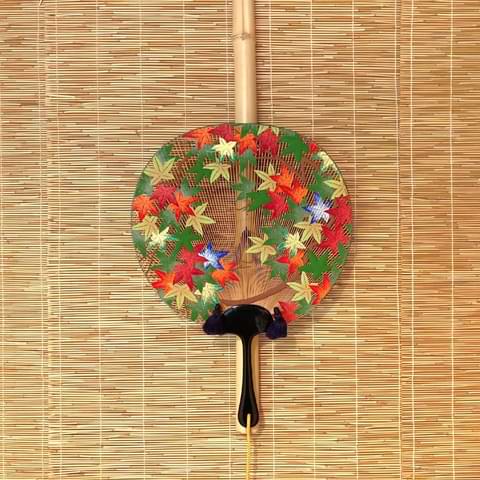
Useful links
Day 16 - Kyōto, Kōbe & Ōsaka
Itinerary of the day
Photo gallery
Typical products and souvenirs
Tanba-Tachikui-yaki 丹波立杭焼
Tanba-Tachikui-yaki pottery owes its name to its hometowns of Tanba-Sasayama and Tachikui, in the heart of Hyōgo Prefecture. In Tanba-Sasayama it is still possible to visit the production kilns and take part in workshops to make your own souvenir ceramics.
The kilns used to make these ceramics are among the six oldest in Japan, the Rokukoyō, along with the kilns of Bizen, Echizen, Seto, Shigaraki and Tokoname. These kilns take the name of Noborigama and have the particular structure created on long gradients, hence the name that translates as “climbing kilns”. The cooking lasts about 60 hours at 1300° C.
The style that distinguishes these ceramics is their rustic appearance resulting from the union of the ash of pine wood, used to create that translucent “glaze” on the surface of the ceramics following a process of vitrification at high temperatures, and decorations in iron enamel. The union of these two components creates a highly appreciated motif on ceramics that makes each piece unique and not replicable.
At the city of Kōbe you can buy these ceramics at the Hyōgo Furusatokan store or in specialized pottery stores such as Lotta-Kōbe.
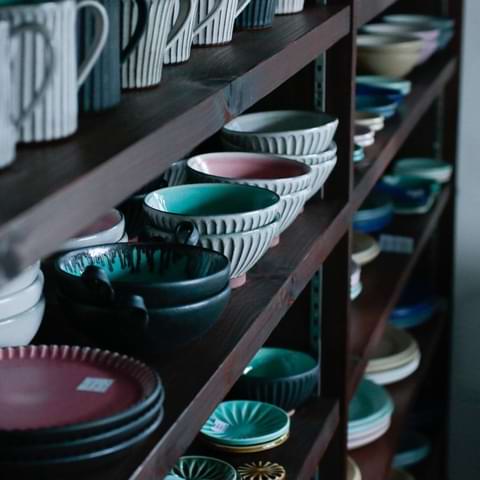
Kōbe-gyū 神戸牛
Considered one of the best meats in the world, Kobe-gyū, or Kobe beef, is so called for a reason of marketing and visibility. The term wagyū in fact refers generically to the four breeds of Japanese cattle Kuroge Washu, Mukaku Washu, Akage Washu and Tankaku Washu.
In fact, the appropriate name would be “Wagyū of Tajima” as only Kuroge Washu bred in the Tajima region, an area of Hyōgo Prefecture north of Kobe, and meeting certain characteristics can be classified under the brand name “Kōbe wagyū“.
The standard of these meats is very high, for this reason it is important to pay attention to the choice of restaurants in which to consume it: many restaurants serve meat of lower quality in astronomical figures. Usually, the most established and well-known restaurants require advance booking that must be made several days, if not even weeks or months before.
The Aoyama restaurant, like the historic restaurants of the elegant Mouriya chain, are among the places where you can try quality meat, traditionally cut and cooked in front of the customer on large teppanyaki. In these restaurants you can choose between different cuts of meat at different prices and even different menus. On average it starts from a price of about 50-70 euros to reach 130-170 euros for the highest quality fillets.
For more information on this typical product, you can refer to the insight at chapter 16 of the autumn book.
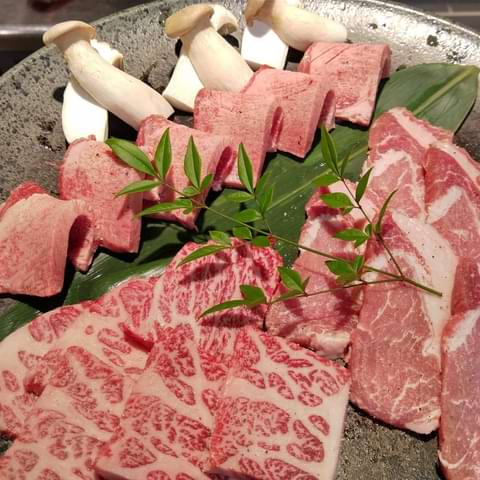
Kitsune udon きつねうどん
The kitsune udon is a delicious udon soup in dashi broth served with naruto-maki fish, spring onions and inari-age, a variant of the fried tōfu in batter, the abura-age, which is marinated in soy. This dish is a classic of Japanese cuisine originating from the city of Ōsaka.
Kitsune means “fox” in Japanese and it seems that the origin of the name goes back to the fact that inside the soup there is the abura-age, the favorite food of foxes according to Japanese folklore.
Although this soup is as popular as it is popular, the best restaurants to try it are in Ōsaka. Among them is Dōtonbori Imai Honten, the first store of the famous chain of soup restaurants located along Dōtonbori Street, and Usamitei Matsubaya, a historic restaurant in the heart of the city.
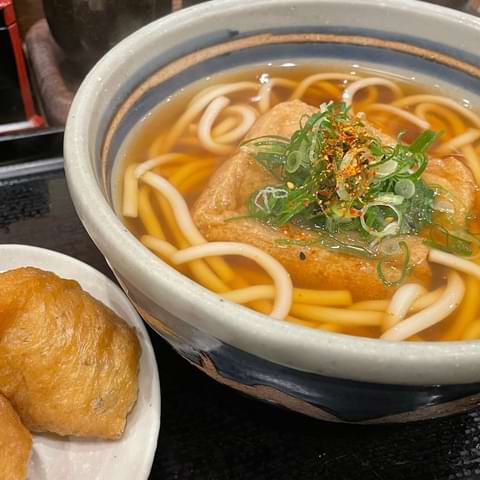
Kushitatsu 串カツ Takoyaki たこ焼き and Tonpeiyaki 豚平焼き
Dōtonbori, in addition to being the famous street of neon and extravagant signs, is considered the homeland of the best street food in Japan. Here you can enjoy takoyaki, kushikatsu, okonomiyaki, grilled gyōza, crab claws and yakitori.
Particularly recommended are kushikatsu, also called kushiage, vegetable skewers or breaded and fried meat. These skewers originating from Ōsaka are dipped in a sweet and sour sauce similar to tonkatsu sauce that enhances the delicious flavor. The city is full of places to eat them, but there are also specialized restaurants. With time and diffusion in cities such as Tōkyō and Nagoya, this dish has gained popularity and has risen from simple street food to sought-after specialties.
Today there are also new types of kushikatsu restaurants where customers fry the skewers at the table in a deep pan with cooking oil. Kushinobō is a typical high-end restaurant with franchises all over Japan, appreciated for serving this specialty in different variations at the tables until the customers are not satisfied.
Another native food of Ōsaka is takoyaki, batter balls cooked in special molds and stuffed with octopus, ginger and spring onions, accompanied by takoyaki sauce, mayonnaise, aonori and katsuobushi flakes. In the past, octopus was the only ingredient used in the recipe.
Needless to say, this dish can be tasted in every corner of Dotōnbori, just follow the signs depicting cute octopus or the scent of stalls along the way. Aizuya is the shop where the takoyaki was invented for the first time.
In Ōsaka okonomiyaki is present in an original way under the name of tonpeiyaki, an extremely simple recipe that does not use a batter but exclusively egg, omelette-shaped.
To eat great okonomiyaki (and its variations) there are restaurants like Ainoya Honten, always with long queues of waiting customers, and even some starred restaurants right on Dotōnbori. Among these, Mizuno is the best known restaurant in the area.
To breathe even more of the typical atmosphere of street food, it is recommended to take the Tonbori, the walk parallel to the Dōtonbori along the homonymous river, where several stalls and locals are struggling with hot plates filled with takoyaki and braziers set of succulent skewers.
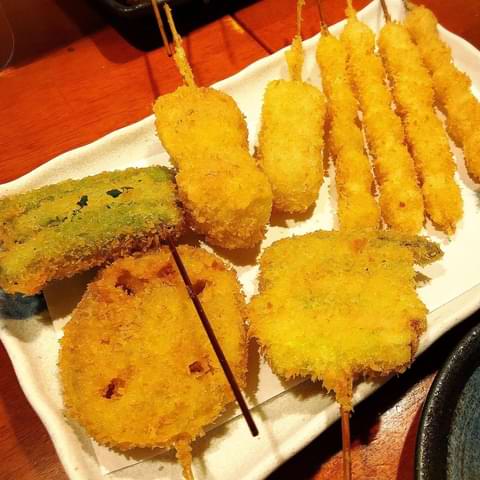
Useful links
Day 17 - Hakone
Itinerary of the day
Photo gallery
Typical products and souvenirs
Yosegi-zaiku 寄木細工
Yosegi-zaiku is a type of traditional Japanese inlay developed in the Edo period in the city of Hakone. Similar to a type of mosaic, it is known for its refined workmanship and for the textures from which it is characterized.
The works of yosegi-zaiku are usually boxes and particularly characteristic are those of puzzles, the himitsu-bako, with various secret chambers that require specific and very elaborate movement patterns to open. The wooden mosaic patterns on its surfaces are thin layers created by gluing together rods and wooden slats of different colors. The surface is then sanded and lacquered to create a durable final product.
The beauty of the geometric patterns depends on the wide variety of wood used, possible thanks to the high number of tree species present throughout the park of Hakone. In this way, the processing of these products gives a wide spectrum of natural colors within the geometric patterns that makes cabinets, boxes, coasters, trays and other items for the house truly charming unique pieces.
While similar techniques exist in a few other areas of Japan, the invention of the yosegi-zaiku technique is attributed to Ishikawa Nihei, a craftsman who lived near Ashi-no-ko Lake in the heart of Hakone. The product has been very successful thanks to the tourism of the area.
The historic craft shop Hakone Maruyama has a shop equipped with all kinds of objects yosegi-zaiku, with various types of mechanisms that the owner likes to illustrate to his customers. These souvenirs can also be found in shops in the area around Gōra and Ōwakudani. Finally, at the Sekisho Karakuri Hakubutsukan Museum are on sale many other creations of local crafts.
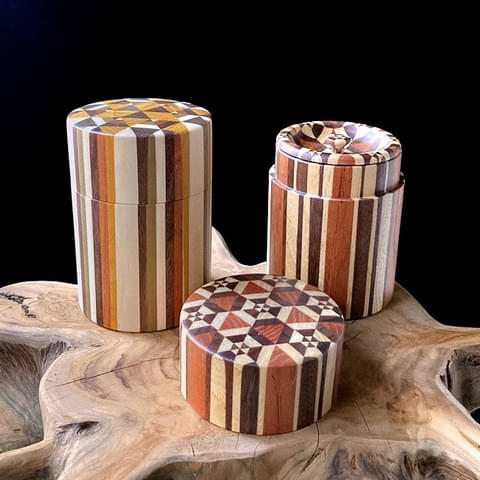
Odawara-shikki 小田原漆器
Odawara-shikki is a type of lacquer typical of the city of Odawara, Kanagawa Prefecture, and widespread throughout the Hakone area. It has a very glossy finish that, unlike many other lacquers, is extremely transparent and highlights the elegant veins of the wooden material below. The pieces thus made are very durable and used daily.
The main lacquering technique is suki-urushi in which the base is prepared by shaving the wood with a potter’s lathe and repeatedly coating with lacquer before polishing. The raw lacquer has antibacterial, waterproof, corrosion-resistant and heat-insulating properties while the wood used comes mainly from zelkova trees.
In the town of Hakone-Yumoto there are many souvenir shops selling these products, starting with those in the station, but the products can also be purchased in the spa areas of Hakone.
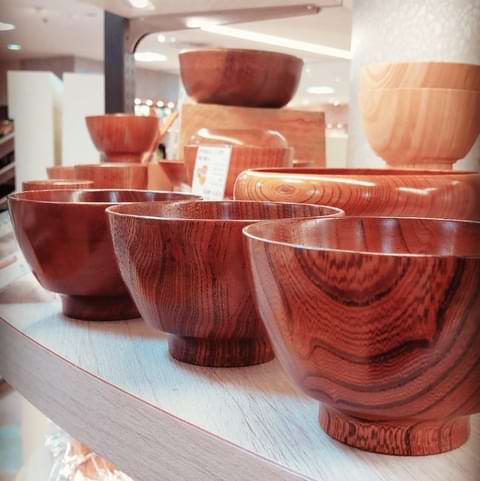
Kuro-tamago 黒玉子
Literally “black eggs”, Ōwakudani’s Kuro-tamago are eggs boiled in thermal water that turn black due to the reaction between iron sulfide and hydrogen sulfide from volcanic gases. The taste is more pronounced but still delicious.
There is also a legend that the properties of hot springs prolong life. In Ōwakudani there is in fact a statue of a Jizō known as Enmei Jizō Bosatsu, who promotes the education of children and is known as a symbol of good luck and longevity, so that if you eat Kuro-tamago they are said to be added seven years to their lives.
Ōwakudani’s black eggs are famous throughout the area and can be purchased in bags at the Kurotama Shop in Ōwakudani.
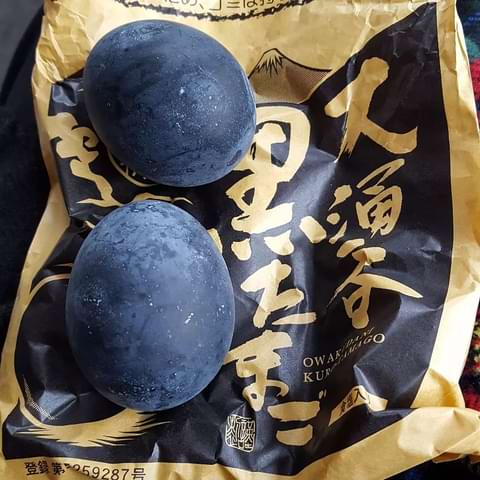
Hakone museum souvenirs
The Sengokuhara area, north of Gōra, is full of themed museums that offer interesting tours, as well as offering its dining spaces with local products and souvenir shops where you can buy local crafts or related to the museum itself.
The Chokoku-no-mori bijutsukan, opened in 1969, was the first open-air museum in Japan, characterized by a green hill and a breathtaking view of valleys and mountains. In the relaxing setting of the museum are exhibited about one hundred and twenty sculptures by artists from all over the world.
The Hakone Shisseika-en Botanical Garden was founded in 1976 and now contains about 1700 varieties of plants, including over 200 types of woody and herbaceous plants from the wetlands of Japan.
The Hakone bijutsukan Art Museum, surrounded by beautiful Japanese gardens, is a small space that displays a fascinating collection of Japanese ceramics from prehistoric times to the Edo era. The landscaped garden of Sekiraku-en is particularly spectacular in autumn, when the red and orange maple leaves are most vivid, while the rain of the summer season colors the museum’s moss garden with bright green.
The Pōra bijutsukan Art Museum, opened in September 2002 within the Fuji-Hakone-Izu National Park, houses a collection of over 9,500 works including many of French Impressionism and the École de Paris but also Monet, Picasso, Fujita and contemporary artists. The museum also added a hiking trail along the museum park intended for guests to enjoy the landscape of the national park.
The Venetian glass museum Garasu-no-mori bijutsukan is characterized by Italian-style buildings framed by mountains and embraced by landscaped gardens, outdoor glass sculptures and trees dripping in delicate glass raindrops. It houses a collection of over 100 pieces of Venetian glassware and exhibits both modern and classic works in all shapes, including vases, chalices, lamps and sculptures. In stores there are thousands of glass accessories from Venice and other parts of the world.
The Mononofu-no-sato bijutsukan samurai museum is a small museum that displays a collection of artifacts from the Edo and Muromachi periods. The main attraction is the impressive collection of samurai armor that guests can try on. There are also weapons, ukiyo-e woodcuts, Nō masks, lacquer items, and tea ceremony utensils that can be purchased at the gift shop.
The Lalique Museum is an elegant museum immersed in the greenery of Sengokuhara that houses over 1,500 pieces by French designer René Lalique. Next to the permanent exhibition, guests can enjoy French food at the on-site restaurant, stroll through a well-tended Japanese garden, and even take afternoon tea on an Orient Express wagon, which features glass interior panels designed by Lalique.
The Okada bijutsukan Art Museum is a modern building with a glass facade nestled in the Ōwakudani Hills. Its permanent collection spans five floors and exhibits Japanese paintings from the Edo era to the present, as well as Asian ceramics and lacquered objects, Chinese metal objects and Buddhist art. The natural thermal foot bath overlooks one of the museum’s largest murals, while at the back of the museum you can access peaceful gardens of carp ponds, waterfalls and flowers.
Wagashi from Gōra and Hakone-Yumoto area
In the Hakone and Gōra area you can try many types of local wagashi. Several shops have a long tradition in the production of fresh and packaged sweets that have become representative of this area and are sold as souvenirs, below some of the most famous.
Yumochi is a mochi made only by Chimoto bakery at Hakone-Yumoto. The mochi includes pieces of finely chopped yōkan jelly kneaded in the glutinous flour of Shiratama-ko rice, giving rise to a dessert that is compared to the rocks of the Haya-gawa River flowing through Hakone. The kanji “yu” of the name means “hot water” and is called in this way for its softness reminiscent of that of the skin after taking a hot bath in an onsen.
Hakone Silver Maple Pancake is a very soft pancake made with soy milk from the Gindōfu store in Gōra. The inside of the pancake has a delicious custard and a filling of maple syrup. You can buy it in Hakone-Yumoto at souvenir shops such as Hakone-no-ichi.
Tsugi-no-Usagi is a chestnut manju that resembles a moon and a rabbit and contains an entire yellow chestnut inside. It is sold by the famous local pastry Nanohana also famous for the production of another typical dessert of Hakone, the Baumkuchen with citrus jam.
Hakone Onsen Manjū is a product of the historic Marushima Honten store that has been in business for over 120 years. This kind of thin-skinned sandwich filled with black honey is characterized by its small and cute size. There are two colors, brown and white, and each is carefully steamed and packaged in art boxes.
Kuro Choco Tamago is a black chocolate whose “yolk” is made of white chocolate and contains an almond, imitating the black eggs of Ōwakudani. You can buy it in several stores, for example at Hakone-no-ichi.
Kikukawa Shōten’s Castella-Yaki Hakone Manjū is a manjū of fluffy castella stuffed with white bean paste from Hokkaidō. At the store you can observe the process of cooking these treats and eat them hot.
Hakone Ryujin-Anpan from Hakone Bakery is a sweet bean paste sandwich. The bread is made with sourdough and water from the Hakone-jinja shrine and is said to bring good luck.
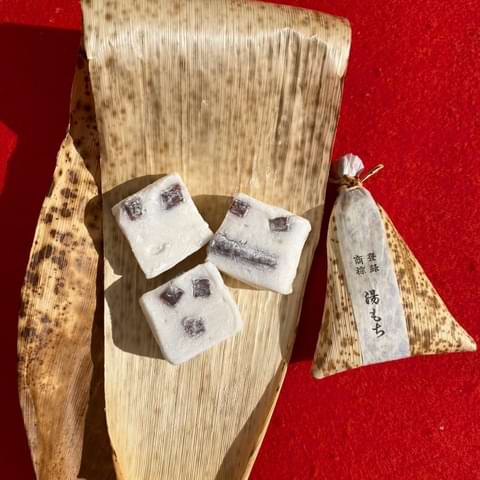
Tōfu cooked with thermal waters
Hagino-tōfu is a traditional tōfu store in Hakone-Yumoto that has been operating for over 200 years. Using Hakone’s delicious thermal water, prepare a solid tōfu made early in the morning. The store also prepares other soy milk delicacies, such as sesame tōfu, tōfu nama-Yuba skin, and ganmodoki, which is tōfu fried with sliced vegetables.
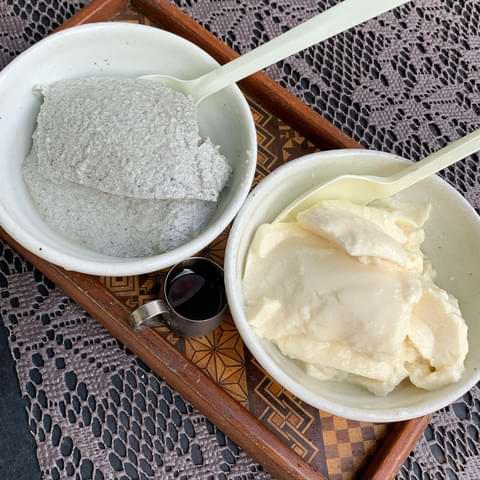
Useful links
We really hope that reading is thrilling you!
If so, we would be very grateful if you could leave a star rating or a short review to the book on amazon, not having a publishing house behind it would be of great help!
Also, don’t hesitate to let us know your impressions on Instagram and Facebook using the hashtag #fourseasonsinjapan or by tagging @cuor.di.manju in your posts/stories.
Day 18 - Hakone & Tōkyō
Itinerary of the day
Photo gallery
Typical products and souvenirs
Shopping at Odaiba
Odaiba Island is full of shopping malls, below the main ones but since in Tokyo shops are subject to sudden changes, check if the store is still open before visiting it (for example, we have been informed that Venus Fort, which we visited in 2018, then closed).
Aqua City Odaiba has a shopping area where about 60 shops are gathered and the largest gourmet area of the coastal area. In addition, on the upper floors there is the Tōkyō Rāmen Kokugikan, full of different rāmen bars, and the Aqua City Odaiba-jinja shrine on the seventh floor terrace of the building, offering its visitors a special view.
Decks Tōkyō Beach, in addition to Japanese and international brand stores and restaurants from which you can enjoy the impressive view of the Rainbow Bridge, houses the Takoyaki Museum, the nostalgic Daiba 1-chome Shōtengai and the Joypolis Technology Amusement Park.
DiverCity Tōkyō Plaza is a structure that offers not only shopping opportunities but a complete range of entertainment, relaxation, surprises and uniqueness. There are many cutting-edge fashion brands, both domestic and imported. The mall overlooks the square where the large statue of Gundam Unicorn is located.
In the Ariake Garden, in addition to about 200 commercial facilities, there are several walks where you can enjoy the changes of the four seasons. The 4 terraces of the building also have a relaxing space where you can enjoy a spectacle of fountains of lights, sounds and water.
"The Gundam Base" and surrounding area
At the Center Plaza of Odaiba’s DiverCity Tōkyō Plaza, the large statue of Gundam Unicorn attracts thousands of tourists every day and is now one of the undisputed symbols of the island. The new RX-0 Unicorn Gundam replaced in September 2017 the previous model built in 2009 as part of the Green Tōkyō Gundam Project, which detailed the RG 1/1 RX-78-2 Ver. Mobile suit GFT controlled by the character Amuro Ray of the popular anime and manga series Gundam.
The statue of Gundam, 19.7 meters high weighing 49 tons, is white in color but from its interior, in the evening, stand out the luminescent colors of LED panels that glow red or green. At certain times the statue transforms from its Unicorn version, with the horn clearly visible in the center of the forehead, to the Destroyer one, with the horn opening in the classic V-shaped coat of arms, making small movements also in other parts of the body.
In the evening, however, between 19:00 and 21:30, every half hour audio-visual performances are performed with projections on the wall of the mall behind it along with Gundam-themed songs. Of course the calendar of the shows can undergo changes also because of the bad weather so always better to take a peek. Finally, the real wonder for collectors is the large Gundam Base store inspired by the Gundam brand, opened in 2017 to replace the Gundam Front Tōkyō.
Useful links
Day 19 - Tōkyō
Itinerary of the day
Photo gallery
Typical products and souvenirs
Omamori お守り and Omikuji おみくじ at Sensō-ji Temple
At the main building of Sensō-ji Temple, as with almost all temples and shrines in Japan, amulets and talismans related to this sacred place are sold.
The omamori pendants are amulets in which the power of the gods is infused to protect those who buy them. Usually composed of a rectangular cloth bag in which a prayer or a message of good luck is kept, they can be of different types, for example to recall prosperity, to protect against accidents, for a healthy growth of children and so on.
In addition to the rectangular cloth bag, there are also other types of amulets such as the bells or the lotus-shaped omamori with the image of the Kannon Bodhisattva. On these amulets was held a special ceremony known as “the gift of prayer” in which chanted sutras took place and burned incense was spread on them.
The Asakusa-jinja Shrine, located near the Sensō-ji temple, is the place where three deities are said to be kept. This sacred place is also called Sanja-sama, or shrine of the Three Gods, who have the task of giving divine assistance to sincere prayers. Also here are sold amulets including ofuda, bookmark-like talismans made of various materials such as paper, wood, cloth or metal. On them is written the name of the sanctuary or its kami imprinted with the seal of the sanctuary.
Finally, another amulet to take away with him after visiting the Sensō-ji Temple is omikuji, prophecies written on paper. They usually require a small offer and are randomly extracted from a box, although each sacred place has its own way of offering these paper charms.
At Sensō-ji Temple, for example, there are special places near the purifying fountain and the censer to make their offerings. Then you take a box full of sticks and shake it to let out a stick to which corresponds your omikuji. If the prophecy is auspicious it can be kept with you, otherwise it must be tied to the appropriate supports and left there to get rid of misfortune.
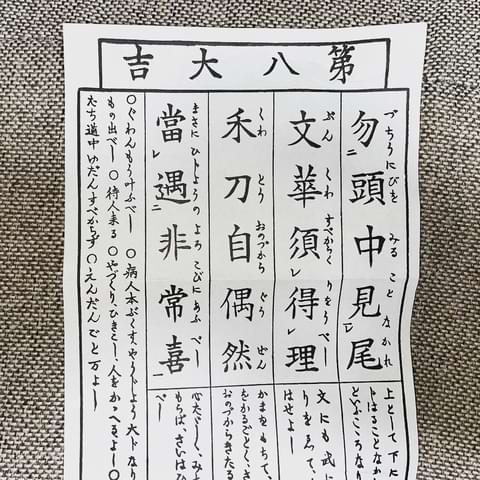
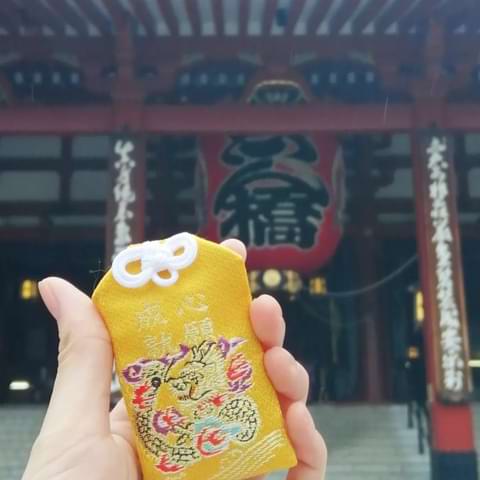
Goshuin 御朱印 at Asakusa-jinja Shrine
The goshuin is a seal seal given to visitors to Shinto shrines. These stamps are collected during the visit to the shrines in the first days of the new year and during the pilgrimages, as proof of presence at the shrine. At the Asakusa-jinja Shrine you can get your own stamp-souvenir passing through the special boxes that also sell lucky charms.
To create the goshuin, the writer, generally the Shinto kannushi priests, presses one or more stamps on the paper and uses black ink to write in his calligraphy the name of the place, the day of the visit and other messages on and around the stamped parts.
At the shrine, with a specific offer and at certain times, you can choose your own goshuin remembrance of the visit to the complex among those present, and there are also special versions for some times of the year, such as seasons or for the first visit of the year.
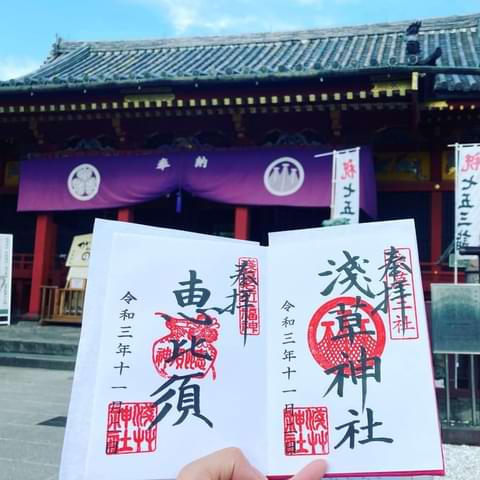
Kappabashi-dōgugai かっぱ橋道具街
Kappabashi-dōgugai, literally “the way of kitchen accessories”, is a stop recommended for all cooking enthusiasts and those looking for original thematic souvenirs to bring to friends and relatives. Due to its proximity to the Asakusa district, we recommend a visit together with the Sensō-ji Temple, but watch out for the day as many shops are closed on Sundays and on Japanese holidays.
The shops along the way are divided into 4 categories: some sell kitchen utensils such as pots and colanders, other professional equipment such as ovens and hobs, others still reproductions of food and finally ceramics and table accessories.
Food reproduction shops are perhaps the best idea if you are looking for funny souvenirs to distribute to friends and family. You can find anything from a single takoyaki meatball to rāmen bowls with chopsticks pulling up spaghetti. But beware of the price as they are anything but cheap!
If you want to go more traditional, like ceramics and various crafts, there are several shops that sell all the accessories for the table and, generally, outside the store are exposed super discounted stock leftovers, probably old lines of products.
For those who love to cook, there’s everything from knives to restaurant tags, from Norens to signs to tōfu molds in tool shops. And again colanders and spatulas of all sizes, the only problem is to find what you are looking for among all the items on display!
Finally, the shops of household appliances that, of course, rarely see foreign tourists as the regular customers are Japanese residents.
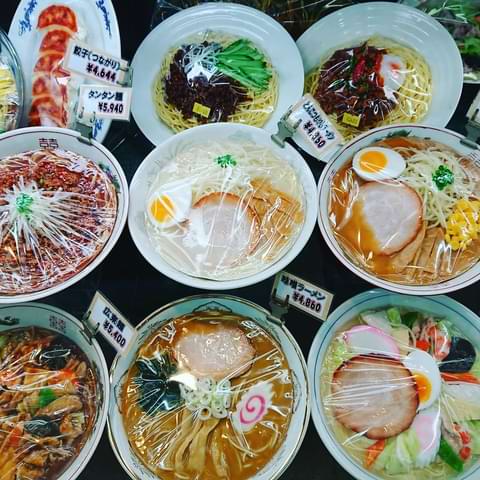
Asakusa traditional sweets
Visiting the beautiful historic area of Asakusa undoubtedly puts appetite. Between one shop and another you can enjoy a sweet snack among the various shops present, many of which offer historical recipes to their customers.
In the historic bakery of Asakusa Kagetsudō you can eat a delicious meron pan, a type of sweet bread with a crispy surface similar to the surface of a melon and the inside with a soft and light texture. The store offers unique versions of meron pan filled with vanilla ice cream or green tea ice cream. The second floor of the store is a Japanese-style cafe where you can taste other traditional sweets such as kakigōri.
Along Nakamise-dōri Street, Chōchin Monaka’s shop serves the historic monaka rice wafer, an ancient Japanese dessert that goes well with tea or as a delicious snack, consisting of two wafers made from crunchy rice that surround an interior filling of azuki bean paste.
From Kamejū, just outside the Kaminari-mon Gate, you can taste one of the best dorayaki of the city whose azuki jam is prepared according to the traditional recipe. Dorayaki, which has become famous as Doraemon’s favorite dessert, is a sweet made up of two slices of pancakes stuffed in a piece of azuki bean jam. Kamejū is famous for making dorayaki larger than the classic format, with a really soft pancake dough and a Tokachi azuki bean paste.
Just beyond that, Funawa is a famous bakery with a history of over 100 years known for its imo-yōkan, famous jelly very much in vogue to accompany tea made from the Japanese satsuma-imo sweet potato. Also famous are her pancakes and sweet potato puddings and anko-lady ball-shaped.
Also near the Kaminari-mon Gate, the Courage Asakusa bakery bakes a sweet bread characteristic of the neighborhood, the Asakusa anpan, a fluffy cube-shaped sandwich is stuffed with a layer of fresh cream and azuki bean paste that makes it really delicious.
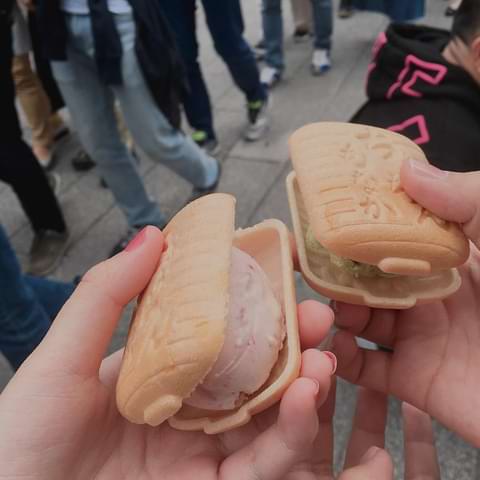
Nakamise-dōri 仲見世通り
Nakamise-dōri is 250 metres long and is home to over 90 gift shops and eateries. Along this path you can indulge in choosing the perfect gift to take with you.
Japanese accessories and the most traditional products are countless, among the most famous certainly the mini lanterns with the shape of the door Kaminari-mon, tabi socks and geta sandals, onsen towels and furoshiki fabrics, wooden sun umbrellas, Lucky cats Maneki neko or masks of Japanese folklore.
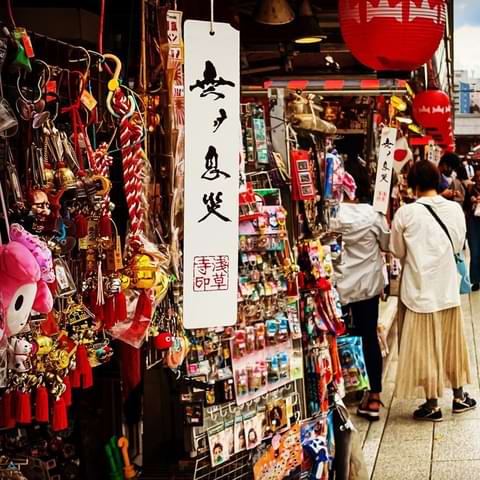
Shopping nerd in Akihabara
Visiting Akihabara means coming home with tech gadgets, Japanese-language manga, or action figures from your favorite series. Needless to say, the hundreds of shops offer such a wide choice that you have to arm yourself with good patience and dedicate a whole day to the infinity of multi-storey shops.
The official site of the neighborhood can give a first useful help to identify the various thematic areas of shopping present. One of the recommended tours that allows you to explore multiple shops in a short time starts from the A3 exit of the Akihabara metro.
In this area of the district, also renamed “Akiba Electric Town”, stand the huge buildings of Akiba Yodobashi Camera and Bic Camera Akiba. Here, in addition to being able to buy phones, computers, tablets and all the latest in technology, there are entire sectors dedicated to videogames, collecting and even travel, with accessories and suitcases of all kinds. As tourists you have the opportunity to buy everything discounted with tax-free.
Taking the Chūō-dōri Street you enter the world of arcade games, with numerous arcades where you can try your hand at fishing for plush toys, action figures and gadgets of all kinds, such as the Taitō skyscraper. On this path also begins the reign of manga and action figures with the famous Animate Akihabara, the Akiba Sofmap Amusement Park and the complex Mandarake.
In the west of the district there is the shop par excellence of retro collectibles, or Super Potato. Finally, the skyscraper Edion and the store Don Quijote offer everything and more to those who visit them. Many of these shops offer tax-free spending more than a certain amount.
Of course, these are just the main stores of the neighborhood: just sneak into the streets west of the Chūō-dōri or walk around the subway to understand how inexhaustible the souvenirs of this fantastic district are.
Sweets and gadgets at Square-Enix cafés
In the Artnia café of Shinjuku, a small futuristic structure present under the headquarters of the Square-Enix, software house of video games such as Final Fantasy and Dragon Quest, you can make a snack with tender as delicious compositions of sweets that imitate the characters of the sagas or sip a cocktail that imitates a regenerating potion.
The café is attached to a store that sells action figures, plush and many other gadgets in limited edition difficult to find elsewhere, such as unique items and clothing related to the titles of the manufacturer. Two other Final Fantasy themed cafés are the Final Fantasy Café Eorzea and the Square-Enix Café, both in Akihabara.
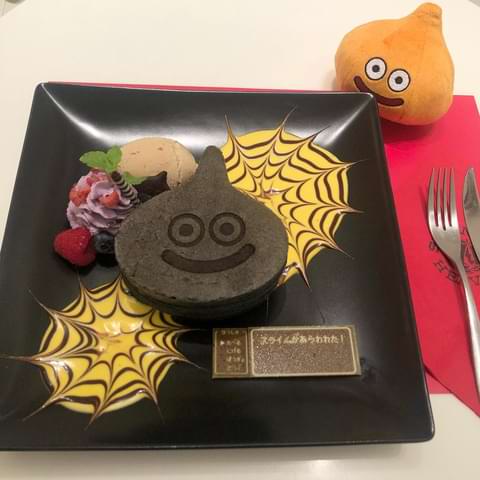
Useful links
Day 20 - Tōkyō
Itinerary of the day
Photo gallery
Typical products and souvenirs
Fashionable shopping in Shibuya
Shibuya is certainly the neighborhood where everything that is fashion becomes accessible to everyone. In fact, unlike Ginza where elegance and style are overpriced, this area of Tokyo offers shops for all wallets.
To start your shopping, you can take the Shibuya Center-gai, a street from which branches the streets Bunkamura-dōri and Inokashita-dōri. From here, after taking your personalized souvenir photo to the famous Purikura-no-Mecca machines, you can indulge in the shopping area dedicated to cosmetics and accessories that is located around Seibu Shibuya.
The beautiful Disney Store that overlooks just beyond, with its imaginative themed building, is a must-see in the neighborhood, as equally popular is the multi-story shop with the famous relief facade Parco. In the huge skyscraper of Daikokuya you can find used accessories and clothing, but the quality of the goods makes you doubt whether they are second-hand products.
Along the street Bunkamura-dōri there is also the department store UNIQLO, well-known Japanese chain of stores of casual clothing and accessories for men, women and children at great prices.
The last essential stop is the all-female shopping at the famous Shibuya 109 mall, between elegant lace dresses and beautiful saleswomen who pamper customers from the beginning to the end of their purchases. For guys who want to get a taste of Japanese men’s fashion, Magnet by Shibuya 109 is for them.
Sweets, clothes and gadgets "kawaii" in Harajuku
The Harajuku district offers its visitors different types of shopping: from the extravagant one along Takeshita-dōri Street, to the youthful one linked to the fashion of international brands along Cat Street, to the more sober and elegant one along Omotesandō Avenue.
Along the Takeshita-dōri are a must try the filled sweet crêpes sold in the various kiosks along the way: in the windows there are dozens of resin reproductions showing delicious crepes from which come out layers of cream, chocolate, fruit and many other ingredients to choose from.
Even the bubble tea kiosks, tea cups but also made of milk and fruit juices that contain jelly balls flavored to various tastes, are widespread, while Totti Candy Factory will allow you to enjoy its rainbow cotton candy in multiple formats, including the coveted giant cone!
Equally enjoyable are the breaks in the colorful themed cafes such as the Pompom Pudding, or the cafes where you can have a snack among puppies and kittens such as the popular Cat Café Mocha, While if you are looking for a more rustic and traditional atmosphere just go into the side alleys, as in Brahms with delicious bars and cafes to discover.
On Takeshita-dōri street you’ll find shops that overflow with cute socks, imaginative T-shirts, nerdy sweatshirts, strange bags and unthinkable shoe collections, as in the case of Tabio, Panama Boy or Out of the World. It goes from classy brands to prints of kittens shooting lasers from the eyes, and again to stores of women’s Japanese fashion brands where elegant lingerie and lace prevails.
There are many boutiques also inside the secondary alleys, with styles such as gothic or lolita, as by Bodyline, or punk and cosplay costumes. Shops like ACDC Rag can prove the level of extravagance achieved here!
As for gadgets, the Daiso store in Harajuku is the largest in Tōkyō, with three floors of items at 100 yen. This shop is a paradise for modern and non-Japanese souvenir items, gifts and traditional toys, and is undoubtedly a great place to buy mini gifts wholesale.
Kiddy Land, on Omotesandō Avenue, is a paradise for traditional toys and gadgets of all kinds. Also noteworthy is the Oriental Bazaar that certainly jumps to the eye with its shop that imitates a Shinto shrine, 3 floors of Japanese souvenirs such as t-shirts with traditional prints, objects, kimono, yukata and other traditional clothing.

Soba-pan 蕎麦ぱん and Soba-inari 蕎麦稲荷
The area around the Jindai-ji Temple in Chōfu is characterized by a well-preserved ancient village through which spring water flows, today identifiable through the presence of some mills and small canals. It was said that this pure and good quality water was suitable for the cultivation of buckwheat, which is why, during the Edo period, local farmers used to offer buckwheat to the temple instead of rice, then used to prepare soba for visitors.
Temple gardens and surrounding streets are lined with soba restaurants, and many of the area’s shops sell sweets and buckwheat snacks. One of the most popular is Ameya’s soba-pan, extra soft steamed buns stuffed with various ingredients such as mustard, red bean paste or keema curry.
Other buckwheat snacks that you can sample in the ancient Chōfu area include soba inari, delicious fried tōfu dumplings filled with soba and flavored with ginger and sesame, cooked over a low heat in a sweet and savory sauce.
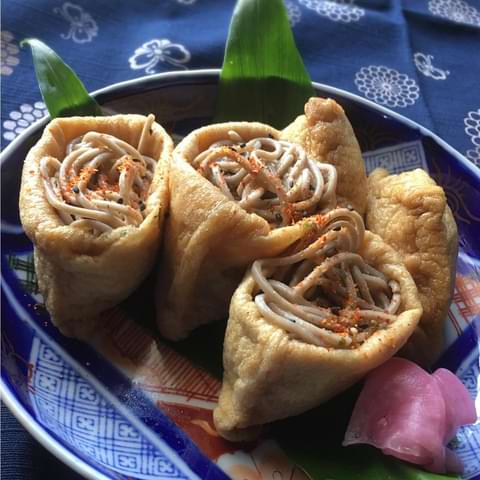
Akakoma 赤駒
If you visit the city area of Chōfu, a trip to the wonderful Jindai-ji Temple is highly recommended, surrounded by greenery and able to give spectacular views full of red maples in the autumn season. At the temple are sold akakoma, figures of horses recreated with straw woven, born as souvenirs for the pilgrims of the temple and additional revenue for the farmers of the area who made them.
The craftsmanship makes each akakoma a unique product, now become a real amulet typical of the area. To sell them is the Ameya store located at the entrance of the temple.
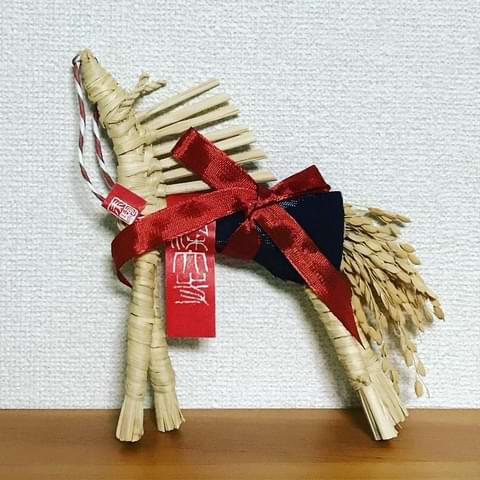
Useful links
We really hope you enjoyed reading!
If so, we would be very grateful if you could leave a star rating or a short review to the book on amazon, not having a publishing house behind it would be of great help!
Also, don’t hesitate to let us know your impressions on Instagram and Facebook using the hashtag #fourseasonsinjapan or by tagging @cuor.di.manju in your posts/stories.
The journey continues in the next volume with a Japanese winter itinerary!


